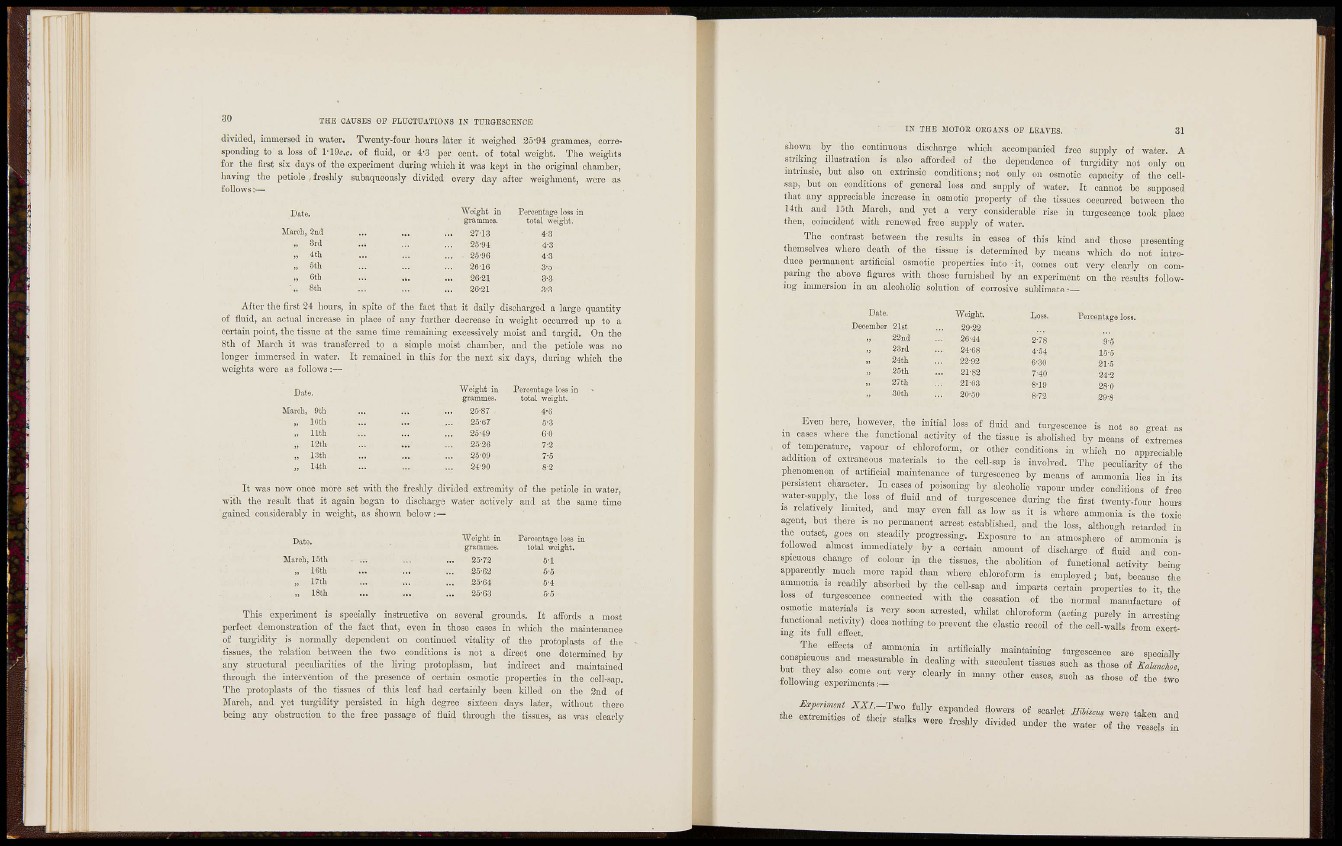
THE CAUSES OF FLTTCTCATIOSS I S TUEQESCESCE
divided, immoraed iu -water. Tweuty-four houra later it weighed grammes, corresponding
to a loss of M9i.\c. of fluid, or 4-3 per eeat. of total weight. The weights
for the first six days of the esperimeiit during which it was kept in the original chamber,
having the petiole , freshly subaqueously divided every day after woighment, were as
f o l l o w s :—
Date.
Maroli, 2nd
„ Srd
„ 4tli
„ Sill
„ Otb
Weight in
grammes.
27-13
2Ô-94
25'S6
26-16
2G-21
26-21
Percentage loss ii
total weight.
3-3
3-3
After the first 24 hours, in spite of the fact that it daily discharged a large quantity
of fluid, an actual increase in place of any further decrease in weight occurred np to a
certain point, the tissue at the same time remainmg excessively moist and turgid. On the
8th of March it was transferred to a simple moist chamber, and the petiole was no
longer inmiersed in water. It remained in tliis for the next si.^. days, during which the
w-eights were as follows ;—
Date.
March, f)th
„ 10th
„ 11th
„ 12tli
„ 13th
„ nth
-^^eight in
grammes.
25-87
25-67
25-49
25-26
25-09
24-90
Percentage loss ii
total weight.
4-6
5-3
6-0
I t -was now once more set with the freshly divided extremity of the petiole in water,
with the result that it again began to discharge water actively and at the same time
gained considerably in weight, as shown b e l o w :—
Date.
March, 15th
„ 16th
„ 17th
„ 18th
Weight in
grammes.
25-72
25-62
25-64
25-63
Percentage loss i
total weight.
5 4
6-5
This experiment is specially instructive on several grounds. It affords a most
perfect demonstration of the fact that, even in those cases in which the mamtenance
of tm-gidity is normally dependent on continued vitality of the protoplasts of the
tissues, the relation between the two conditions is not a dh-ect one determined by
any structural peculiarities of the living protoplasm, but indirect and maintained
throngh thé intervention of the presence of certain osmotic properties in the cell-sap.
q'he protoplasts of the tissues of this leaf bad ccrtainly been killed on the 2nd of
March, and yet turgidity persisted in high degree sixteen days later, without there
being any obstruction to the free passage of fluid through the tissues, as -was clearly
IN THE MOTOR OEGANS OP LEAVES. 31
shown by the continuous discharge which accompanied free supply of water. A
strikmg illustration is also afforded of the dependence of turgidity not only on
intrinsic, but also on extrinsic conditions; not only on osmotic capacity of the cellsap,
but on conditions of general loss and supply of -n-ater. It cannot be supposed
that any appreciable increase in osmotic property of the tissues occurred between the
14th and loth March, and yet a very considerable rise in turgeacence took place
then, coincident with renewed free supply of water.
The contrast between the results ia cases of this kind and those presenting
themselves whoro death of the tissue is determined by means which do not intro"
duce permauent artificial osmotic properties into -it, comes out very clearly on comparing
the above figures with those furnished by an experiment on the results following
nnmersion in an alcoholic solution of corrosive sublimate;—
Date, Weight. Loss. Percentage loss.
December 21st 29'22
22ud 26-44 2-7S 9-5
23rd 24'68 4-54 15--5
„ 24tli 22-92 6-30 21'.5
25tli 21'82 7-40 24'2
27tli 21-03 8'19 28-0
30t)i 20-50 8-73 29-8
Even here, however, the initial loss of fiuid and turgescence is not so great as
m cases where the functional activity of the tissue is abolished by means of extremes
of temperature, vapour of chloroform, or ether conditions in which no appreciable
addition of e.«rancons materials to the cell-sap is involved. The peculiarity of the
phenomenon of artificial maintenance of turgescence by means of ammonia lies in its
persistent character. In cases of poisoning by alcoholic vapom- under conditions of free
water-supply, the loss of fiuid and of turgescence during the first twenty-four hours
is relatively Imnted, and may even fall as low as it is where ammonia is the toxic
agvnt, but there is no permanent arrest established, and the loss, although retarded in
the outset, goes on steadily progrcsshig. Exposure to an atmo,,phei-o of ammonia is
tollowed almost immediately by a certain amount of discharge of fluid and conspicuous
change of colour in the tissues, the abolition of functional activity beinapparently
much more rapid than where chloroform is employed ; but, because the
ammonia is readily absorbed by the cell-sap and imparts certain properties to it the
loss of tm-gescence connected with the cessation of the normal manufacture of
osmotc materials is voiy soon arrosted, whilst chloroform ( a c t i i g purely in an-csthig
i n r i i ° s ' ' f a i r c f l « the elastic recoil of the cell-walls from exert
The efliccts of ammonia in artificially maintainhig tm-geseenco are sneeiallv
conspeuous and measurable m dealing with succulent tissues s u c f as those f « Î — - - -
the i d T t -